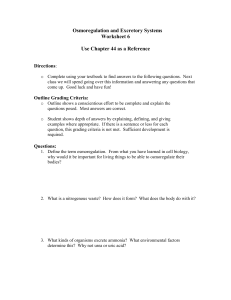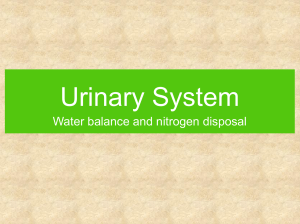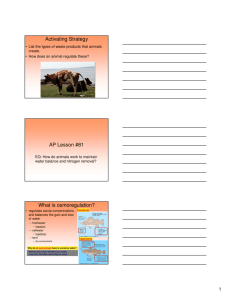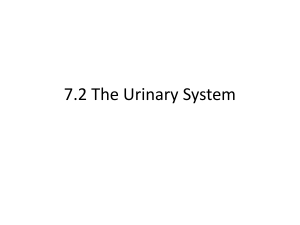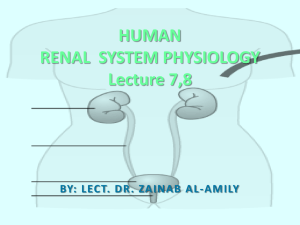Osmoregulation and Excretion
advertisement
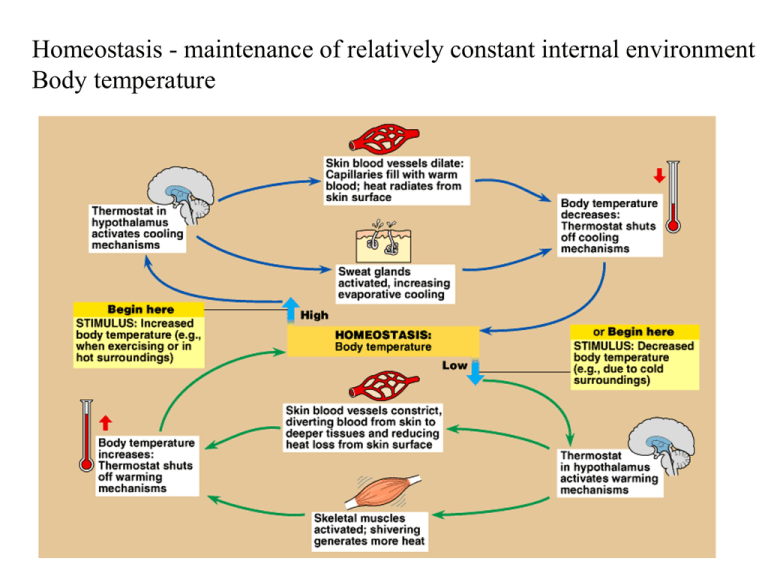
Homeostasis - maintenance of relatively constant internal environment Body temperature Endotherms Mammals and birds generally maintain body temperatures within a narrow range that is usually considerably warmer than the environment. 36-38oC for most mammals and 39-42oC for most birds. Ectotherms Amphibians, reptiles control body temperature mainly by behavior. Thermoregulate Adjusting the rate of heat exchange between the animal and its surroundings. – Insulation – Blood flow - Vasodilation vs.Vasoconstriction Thermoconformers use countercurrent heat exchangers to trap heat in the muscles, digestive tract, eyes, or brain. Homeostasis - Osmotic water/salt balance & waste Osmoregulation - water salt balance salt-excreting glands remove excess sodium chloride from the blood gills of freshwater fishes actively pump salts from the dilute water Transport epithelia in excretory organs maintain water balance and disposing of metabolic wastes. Nitrogenous Wastes In fishes, most of the ammonia is lost as ammonium ions (NH4+) at the gill epithelium Mammals, most adult amphibians, and many marine fishes and turtles excrete mainly urea. Urea is synthesized in the liver by combining ammonia with carbon dioxide and excreted by the kidneys. Advantages Urea requires less water loss 100,000 times less toxic than that of ammonia. Disadvantage must expend energy to produce it from ammonia. Amphibians excrete ammonia when they are aquatic tadpoles, switch to urea when they are land-dwelling adults. Land snails, insects, birds, and many reptiles excrete uric acid as the main nitrogenous waste. Advantages: Uric acid is relatively nontoxic largely insoluble in water excreted as a semisolid paste with very small water loss. Disadvantage: More energetically expensive to produce than urea Adaptations for excreting nitrogenous wastes 1. Mode of reproduction Soluble wastes can diffuse out of a shell-less amphibian egg (ammonia) carried away by the mother’s blood in a mammalian embryo (urea). Shelled eggs of birds and reptiles are not permeable to liquids In these animals, uric acid precipitates out of solution and can be stored as a solid within the egg (allantois) and left behind when the animal hatches. 2. Habitat. Terrestrial turtles - excrete mainly uric acid Aquatic turtles excrete both urea and ammonia. Osmoregulation - balance between osmotic gain and loss of water Animal cells - lack cell walls swell and burst if there is a continuous net uptake of water shrivel and die if there is a substantial net loss of water. Osmosis occurs whenever two solutions separated by a membrane differ in osmotic pressure, or osmolarity (moles of solute per liter of solution). Isotonic (isoosmotic) Hypertonic Hypotonic Osmoregulators expend energy to control their internal osmolarity Osmoconformers -isoosmotic with their surroundings Most marine invertebrates (jellyfish) are osmoconformersosmolarity same as seawater. An osmoregulator must discharge excess water if it lives in a hypoosmotic environment (freshwater) freshwater animals are constantly gaining water by osmosis and losing salts by diffusion. Freshwater protists such as Amoeba and Paramecium have contractile vacuoles that pump out excess water. Many freshwater animals, including fishes, maintain water balance by excreting large amounts of very dilute urine, regaining lost salts in food, and by active uptake of salts from their surroundings. Osmoregulator Take in water to offset osmotic loss if it inhabits a hyperosmotic environment (terrestrial habitats). Marine animals can maintain internal osmolarities different from that of seawater. Marine fishes lose water through their skin and gills. To balance this drink large amounts of seawater and they excrete ions by active transport out of the gills. Marine sharks and most other cartilaginous fishes use a different osmoregulatory “strategy.” Salts diffuse into the body from seawater and are removed by the kidneys, a special organ called the rectal gland, or in feces. Unlike bony fishes, marine sharks do not experience a continuous osmotic loss because high concentrations of urea in body fluids lead to an osmolarity slightly higher than seawater, water slowly enters the shark’s body by osmosis and in food, and is removed in urine. Adaptations that reduce water loss are key to survival on land. Terrestrial animals have body coverings that help prevent dehydration Waxy layers in insect exoskeletons Multiple layers of dead, keratinized skin cells. Humans die if they lose about 12% of their body water Most excretory systems produce a filtrate by pressure-filtering body fluids into tubules. Flatworms have an excretory system called protonephridia, consisting of a branching network of dead-end tubules. These are capped by a flame bulb with a tuft of cilia that draws water and solutes from the interstitial fluid, through the flame bulb, and into the tubule system. Metanephridia, another tubular excretory system, consist of internal openings that collect body fluids from the coelom through a ciliated funnel, the nephrostome, and release the fluid through the nephridiopore. Found in most annelids, each segment of a worm has a pair of metanephridia. Insects and other terrestrial arthropods have organs called Malpighian tubules that remove nitrogenous wastes and also function in osmoregulation. These open into the digestive system and dead-end at tips that are immersed in the hemolymph. Filtrate from Bowman’s capsule flows through the nephron and collecting ducts as it becomes urine Proximal tubule Secretion and reabsorption in the proximal tubule substantially alter the volume and composition of filtrate reabsorption of most of the NaCl and water Descending limb Ascending limb permeable to salt not water Distal tubule Hormonal control of reabsorption contributes to pH regulation secretion of H+ and reabsorption of bicarbonate (HCO3-). Collecting duct Mammalian Kidney counter-current multiplier between the ascending and descending limbs of the loop of Henle desert mammals, have exceptionally long loops of Henle. Antidiuretic hormone (ADH). ADH produced in hypothalamus of the brain and stored in and released from the pituitary gland Osmoreceptor cells in the hypothalamus monitor the osmolarity of the blood. juxtaglomerular apparatus (JGA), Releases renin when there’s a decrease in blood pressure or blood volume in the afferent arteriole
